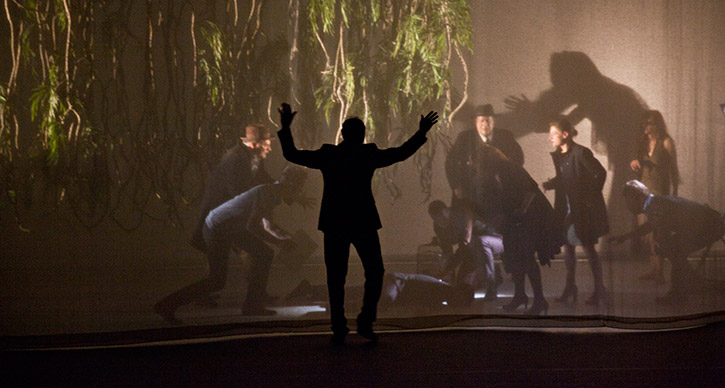Performance Livestream: Steve Reich @ 80
Steve Reich, whom the New Yorker called “the most original musical thinker of our time,” celebrates his 80th birthday in 2016; the year also marks the 40th anniversary of the premiere of Music for 18 Musicians, considered by many to be his greatest composition. On Saturday, March 18, 2017, two of Chicago’s world-class ensembles, Eighth Blackbird and Third Coast Percussion, team up to perform this seminal piece. Reich’s Sextet rounds out the program.
UMS will livestream the performance from Ann Arbor’s Hill Auditorium on Saturday, March 18, 2017 at 8 pm EST. Register to receive reminders and information about the stream:
Archived stream from the performance on Saturday, March 18, 2017:
Read the concert program book [pdf]
You can also sign up for email updates about future streams (choose “Arts & Culture Adventures” list).
Questions? Ask them in the comments below.
Chamber Music on the Rise
 Classical
Classical
The chamber group eighth blackbird performs with the percussion group Third Coast Percussion on March 18, 2017.
Music in the 21st Century is evolving. Performers are trying to find new ways to engage and excite audiences. From collaborating with visual artists to performing from memory, musicians are working to distinguish themselves in a competitive field. Orchestral and symphonic music have always been at the forefront of classical music, but chamber music has recently been gaining a lot of popularity among concert-goers.
As a music student at the University of Michigan, I’ve crossed paths with many rising stars as well as artists who have “made it” in the music community. So, I’ve had a few conversations in and out of school about how classical music is evolving and the attendant positive and negative changes.
Why chamber music has momentum
Programming
From a programmatic standpoint, small ensembles can play a wider variety of shorter pieces that cater to more musical tastes, while a large-scale symphony might have 1 to 3 pieces on the entire hour-and-a-half long program and appeal to only one musical genre.
In my opinion, attending a symphony orchestra concert can be very difficult for families and people who might not regularly listen to classical music. When I was younger, I remember squirming around, making a ruckus, and being unruly for long symphony concerts, but I think chamber ensembles can be more accessible to a wider range of people.
Repertoire
Chamber groups can choose to play transcriptions of famous works, that range from the medieval era to post-tonal melodramas such as Pierrot Lunaire, a piece so influential that it has shaped the concept of how we listen to and perceive chamber ensemble today.
Many chamber ensembles choose to include a dramatic or comedic aspect into their programs, which draws audience members in and allows them to listen to classical music in new ways.
https://www.youtube.com/watch?v=m_QRd8SjKKM
Above is the renowned Mnozil Brass ensemble performing “Lonely Boy,” with an added dramatic element.
Newer chamber ensemble configurations don’t always have a list of standard repertoire; these groups can often hit roadblocks when working to progress as an ensemble. And one of the greatest resources new ensembles have right now is the multitude of living composers who want to help define the standard repertoire, an effect which is also beneficial for the progression of classical music. As much as I love going to see the Chicago Symphony Orchestra perform standard repertoire at the highest level, I also get just as excited to see a group such as the Kronos Quartet perform a program of new works by up-and-coming composers I didn’t even know existed.
Expenses
From a financial view, a chamber ensemble can be comprised from two to a handful performers, and funding a group of this size is easier. Fewer people are employed by the ensemble, so ticket prices don’t have to be as high to generate a successful performance. Chamber ensembles can also perform in smaller and more intimate venues.
Chamber groups aren’t necessarily bound to performing in a “stuffy” symphony hall. As fun as it may be to dress up for the occasion and spend time in a beautiful space, sometimes I just want to hear good music in a more casual and less expensive setting. Chamber group instrumentation is also not set in stone, Options for sound concept, tone color, and blend are unlimited; it really just depends on what the ensemble is trying to achieve.
Chamber music is paving the new path for classical music
One of the most sought after chamber groups in the world, eighth blackbird, is setting the bar for how chamber music can and should be performed. The four-time Grammy Award winning ensemble puts on an array of exciting and diverse programs that attract audience members of all varieties.
eighth blackbird was founded when the original members were still in school at the Oberlin Conservatory and consists of six members and on the following instruments: violin/viola, cello, piano, percussion, clarinets, and flutes, which is the same instrumentation of the Pierrot Lunaire configuration. The ensemble can achieve a wide range of tone colors and sounds and is constantly commissioning and performing new works. The ensemble interacts with the audience and provides information about the works they perform to make the concerts more accessible to people who may not be well versed in classical or contemporary music. eighth blackbird’s visit during the 2016-17 season will be the group’s third performance with UMS.

eighth blackbird. Photo courtesy of the artist.
For this concert, eighth blackbird is teaming up with Third Coast Percussion, an exciting Chicago based percussion ensemble, to perform the instrumental work Music for 18 Musicians (1976) by Steve Reich. If you have never heard the music of Steve Reich, then prepare to have your mind blown. Reich incorporates a minimalist technique in his compositional style, where notes are repeated in an ostinato-like style and the harmonies move very glacially, but you become immersed in the ocean of sound and get swept away. Here is an example of a similar work by Reich: Double Sextet, a Pulitzer Prize winning piece which was commissioned by eighth blackbird.
Performing minimalist music can be mentally and physically straining because it is very repetitive and changes only slightly over time, which can catch the performers off-guard. There are also very few playing breaks in this type of music. The compositions of Steve Reich are very exciting and this all-star group of performers makes for a concert you do not want to miss.
As a musician, I think chamber music has a bright future. There are more and more opportunities arising for chamber groups: including local and national chamber concert series, chamber music competitions for all level players, as well as collegiate degrees that are offered in chamber music at schools as prestigious as the University of Michigan. I think that many musicians are evolving and revolutionizing their playing and how they connect with audiences that are constantly changing. This is a very exciting time for chamber music and I’m happy that I get to tag along for the ride.
Hear Music for 18 Musicians at the Steve Reich @ 80 concert with eighth blackbird and Third Coast Percussion.
UMS Playlist: A Touch of Minimalism
This post is a part of a series of playlists curated by artists, UMS Staff, and community. Check out more music here.

Dawn of Midi perform at Trinosophes in Detroit on January 31, 2015. Photo by Falkwyn de Goyeneche.
Minimalism can be extraordinarily beautiful. I’ve always been a believer of “less is more.” In the right hands, repetition, simplicity, and homogeneous textures of sound can envelop the listener in deeply meaningful and even spiritual ways.
In the playlist below, I’ve attempted to offer a sampling of minimalist techniques in a cross-section of genre and style, from pioneering tape experiments by Steve Reich (“It’s Gonna Rain,” ca. 1965) to minimalist 1990s electronica from the UK’s Richard D. James (aka Aphex Twin) and the Manchester duo Autechre (selected from their seminal 1995 LP Tri Repetae) to Dawn of Midi, a group with a mesmerizing, “electro-acoustic” sound that will perform at Trinosophes on January 31, 2015.
I have also included some surprises: Jason Moran and The Bandwagon’s cover of American-born innovator Conlon Nancarrow (who composed “Study No. 6” for player piano) and downtown New York experimental post-disco songwriter, cellist, and composer Arthur Russell (who died in 1992 at the age of 40 in relative obscurity).
This playlist represents merely a snapshot of some of my favorite minimalist moments. Hopefully it will encourage and inspire a deeper personal journey of discovery.
Please note: These fascinating (and intricate) soundscapes are best experienced on headphones.
What did you think about this playlist? Share your thoughts or song suggestions in the comments below.
Our Top 5 Riotous Performances

Photo: Scene from Six Characters in Search of an Author production by Théâtre de la Ville. Photo by JL Fernandez.
On Saturday, Théâtre de la Ville return to Ann Arbor to perform Luigi Pirandello’s Six Characters in Search of An Author. Luigi Pirandello won the Nobel Prize in Literature in 1934 for his “bold and brilliant renovation of drama and the stage,” and Six Characters, which dates from 1921, is one of his seminal plays, widely considered to be a precursor to the theater of the absurd movement to follow. However, the play caused a riot when it was first produced in Rome in 1921, and was even banned in Britain until 1928.
We were inspired to put together a list of our favorite performance riots. Add your own to the comments below.
1. Igor Stravinsky’s The Rite of Spring – May 1913, Paris
“The ballet was choreographed by the great Nijinsky,” Hoffman says, “and the noise, fighting, and shouting in the audience got so loud, he had to shout out the numbers to the dancers so that they knew what they were supposed to do.” (via)
2. Steve Reich’s Four Organs – 1973, Carnegie Hall, NYC
“One woman walked down the aisle and repeatedly banged her head on the front of the stage, wailing ‘Stop, stop, I confess.’” (via)
3. Ornette Coleman, debut of quartet —1959, Five Spot, NYC
“Coleman’s playing created instantaneous controversy. Miles Davis, Red Garland and Coleman Hawkins were initially openly hostile to Coleman. Dizzy Gillespie said, “I don’t know what he’s playing, but it’s not jazz.” Davis’s comments, “the man is all screwed up inside,” were the ones picked up by the press, but drummer Max Roach took his outrage far enough to follow Coleman backstage one night and punch him in the mouth.” (via via via)
4. Elvis Presley— 1956, The Ed Sullivan Show, NYC
“In the second show, June 5, 1956, Elvis’s playful performance of ‘Hound Dog’ drove the teens wild, but the press and some adults were outraged. The controversy over his bumps and grinds and gyrating hips only served to fuel the fire. When Ed Sullivan was asked if he would book Elvis on his show, he said he would not. He didn’t want to be the recipient of scathing criticism from the nation’s media.” (via)
5. George Bizet’s Carmen premiere — 1875, Paris
“With a libretto based on a story that many considered too salacious for public performance, Carmen was roundly denounced as immoral by critics even before its score had been completed.” (via)
What are some of your favorite performances like this? Why do you think some performances inspire this kind of reaction and conversation while others don’t?


